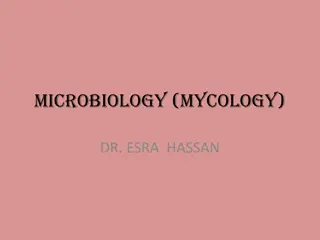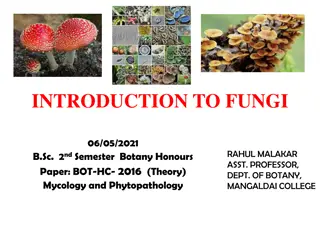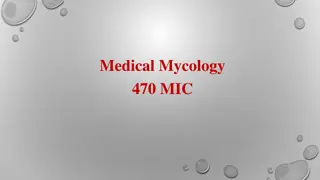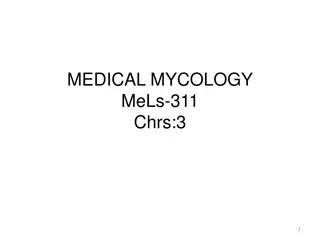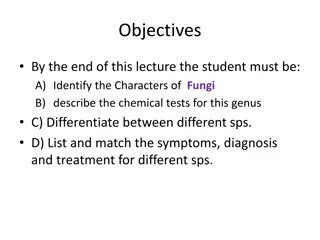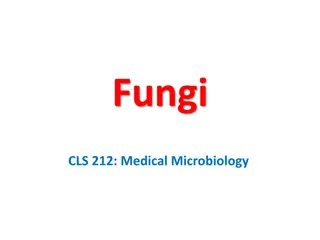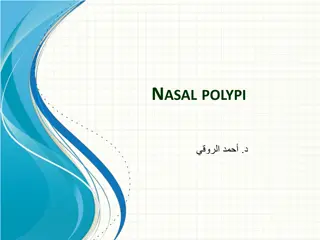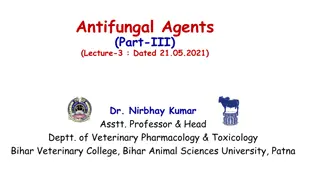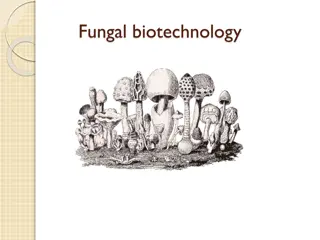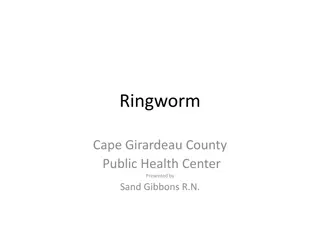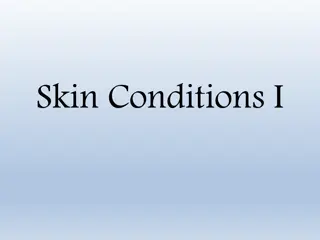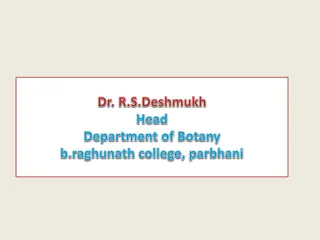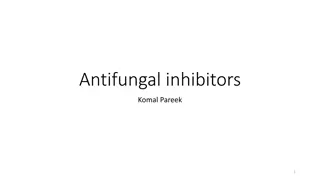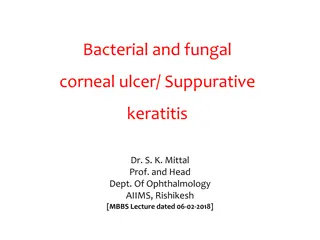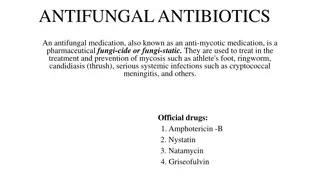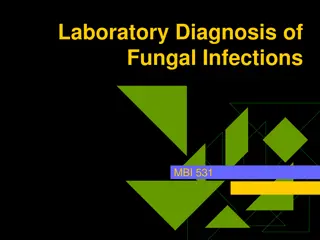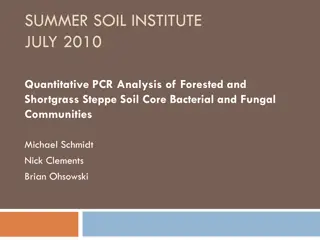Comprehensive Overview of Medical Mycology and Fungal Structures
Explore the field of medical mycology through lecture slides by AL-HEDAITHY covering various topics such as basic mycology, superficial mycoses, primary systemic mycoses, fungal structures, and reproduction in fungi. Dive into details about different fungal infections, their characteristics, forms of reproduction, and examples of fungi structures. The content provides an in-depth look at the world of fungi and their impact on human health.
Uploaded on Sep 13, 2024 | 0 Views
Download Presentation

Please find below an Image/Link to download the presentation.
The content on the website is provided AS IS for your information and personal use only. It may not be sold, licensed, or shared on other websites without obtaining consent from the author. Download presentation by click this link. If you encounter any issues during the download, it is possible that the publisher has removed the file from their server.
E N D
Presentation Transcript
AL-HEDAITHY Medical Mycology Lecture Slides
AL-HEDAITHY List of Contents 1. Basic mycology 2. Superficial Mycoses 3. Pityriasis versicolor 4. Tinea Nigra 5. Piedra 6. Dermatophytoses 7. Mycetoma 8. Rhinosporidiosis Lobomycosis 9. Phaeohyphomycosis 10. Chromoblastomycosis 11. Sporotrichosis 12. Zygomycosis 13. Aspergillosis 14. Pneumocystosis (PCP) 15. Candidiasis 16. Cryptococcosis, Trichosporonosis, Geotrichosis 2 9 10 12 14 17 25 35 17. Primary Systemic Mycoses 18. Blastomycosis 19. Histoplasmosis 20. Coccidioidomycosis 21. Paracoccidioidomycosis 22. Candidosis and Oropharyngeal mycosis (For Dental Students) 23. Fungal Eye Infections 24. Selected references 63 65 67 70 73 75 83 89 37 38 41 43 48 51 53 60 1
Basic Mycology AL-HEDAITHY Mycology: Mykes = Mushroom = Fungi Logos = Study of = Study of fungi Kingdom myceteae (= K. fungi) Characteristics (distinguishing features) 1) All Eukaryotic organisms 2) Heterotrophic do not have chlorophyll (Achlorophyllous) Symbiotic Saprobic Parasitic 3) The cell is surrounded by rigid cell wall made up of chitin & complex carbohydates (Chitosan,Mannan,glucan,galactomannan) 4) Have simple structure most of them microscopic. 5) Reproduce by spore formation sexually or asexually. 2
AL-HEDAITHY Structure of Fungi Examples: Yeast-like 1) Unicellular Yeasts True yeasts cells retain individuality Saccharomyces cerevisiae Candida albicans Cells attach to each others side - by side forming Pseudohypha 2) Filamentous molds Hypha - Hyphae - Septum Septate hypha Examples:Aspergillus, Penicilium Rhizopus Nonseptate hypha (coenocytic hypha) Interwoven hyphae = Mycelium Dimorphic: Have two forms depending on change in the environmental factor like Temp., Medium and culture Vs Host Monomorphic: Only one form regardless of environment. 3
Reproduction in Fungi I) Asexual: Only mitotic cell division 1) Somatic 2) Spore formation: a) Sporangiospores in sporangia b) Chlamydospores in or on hyphae c) Conidia (conidium) on hypha or on conidiophores Asexual reproductive structures: Yeasts by budding Molds by hyphal fragmentation Many types of conidia like: Blastospore, arthrospore, aleuriospore, sympodulospore etc Conidiophore Conidium Synnema Sporodochium Acervulus Pycnidium Imperfect fungi = Deuteromycetes: Do not reproduce sexually or their sexual reproduction not known e.g. Aspergillus, Fusarium, Candida 4
II) Sexual: Fusion, mitosis, meiosis Sexual spores: Oospore, Zygospore, Ascospore, Basidiospore Zygospore Zygomycetes e.g. Rhizopus, Mucor Ascocarp Ascus Ascomycetes Ascospore Basidiocarp Basidiospore e.g. Truffles Terfezia & Termania Basidium Gills Basidiomycetes e.g. Mushrooms & Podaxis pistillaris (Agaricus campestris) 5
AL-HEDAITHY Groups of Fungal Infections: 1) Superficial Mycoses 2) Cutaneous Mycoses 3) Subcutaneous Mycoses 4) Systemic Mycoses 5) Opportunistic Mycoses 6) Actinomycetous Infections 6
Classification of Fungi Taxonomy: Based on morphological, Physiological, Genetic & Molecular characteristics. Taxon = Classification rank. Kingdom: Myceteae Division: Amastigomycota Subdiv: Deuteromycotina Binomial system Latin Class: Sub. class: Hyphomycetidae Deuteromycetes Author M.canis Bodin Order: Moniliales Family: Moniliaceae Genus: Microsporum Species: Canis Variety Strain Primary Pathogen Opportunistic Pathogen 7
AL-HEDAITHY Classification of Fungi Kingdom Myceteae 1- Div. Gymnomycota: naked (No cell wall), phagotrophic Myxamoeba, slime molds Class Acrasiomycetes, Cl. Protosteliomycetes Cl. Myxomycetes e.g. Dictyostelium 2- Div. Mastigomycota: flagillated, motile Cell wall, absorptive nutrition, if mold nonseptate hyphae Chytridiomycetes, Hyphochytridiomycetes Plasmodiophoromycetes, Oomycetes e.g. Phythium, Phytophthora 3- Div. Amastigomycota: Non flagellated, Non-motile Yeasts & molds: Septate hyphae & non-septate Cl. Zygomycetes, Trichomycetes, Ascomycetes, Basidiomycetes Deuteromycetes (Fungi Imperfecti = Imperfect fungi) e.g. Aspergillus, Penicillium, Fusarium, Candida 8 Old terms: Phycomycetes, Aquatic, Lower fungi, Higher fungi
Superficial Mycoses These affect the uppermost dead layers of skin or hair shaft. They are painless and usually do not provoke the immune system They primarily include: 1- Tinea versicolor (= Pityriasis versicolor) Brown or discolored or white patches on the skin. 2- Tinea nigra (T.n. palmaris) Dark brown or grey macular lesions usually on palm of hand but can be on sole of foot or others. 3- Piedra Nodules of the etiologic fungus on hair shaft; a. Black piedra b. White piedra 9
Superficial Mycoses (Continued) Pityriasis Versicolor (= Tinea versicolor) Brown or discolored, or white patches on skin Affect the stratum corneum The white lesions do not tan in the sun Endogenous source of infection Etiology: Malassezia furfur It is a Yeast (= Pityrosporum orbiculare) Blastomycetidae, bipolar budding, Skin flora Lipophilic: oleic acid Or Mineral oil Laboratory Diagnosis: Specimen is skin scrapings 10% Or 20% KOH will show short hyphal segments and round yeast cells (spaghetti & meat ball appearance) Culture on SDA and Mycobiotic medium (=SDA+ Chloramphenicol+ Cycloheximide = Actidione) with oily substance. 10
Superficial Mycoses (Continued) Pityriasis Versicolor Round cell Hyphal segment Scrapings in KOH M. furfur In culture 11
AL-HEDAITHY Superficial Mycoses (Continued) Tinea nigra (= T.n. palmaris) Macular brown lesions or black stripes on palm of hand or sole of foot. Acquired by Piercing of skin with plant material in Agricultural soil. Etiology: Dematiaceous imperfect mold fungus; Phaeoannellomyces werneckii (=Exophiala werneckii) In vegetation debris In culture it produces annellospores from annellids,unicellular or two celled. Laboratory Diagnosis: Skin scrapings: - In 10% or 20% KOH will show brown septate hyphae Culture on SDA & Mycobiotic. Will grow the dematiaceous fungus. Do Lactophenol teased mount (LTM) & LPCB (Lactophenol cotton blue) for identification. 12
AL-HEDAITHY Superficial Mycoses (Continued) Tinea nigra Petri plate In KOH 3 wk old colony Conidia Phaeoannellomyces werneckii (Exophiala werneckii) 13
Piedra AL-HEDAITHY Nodules or Encrustations on hair shaft The nodules are composed of fungal elements On scalp hair / - mustache, beard Usually in Tropics & subtropics Black piedra Assostroma with asci & ascospores Hyphal strands Firm, hard, dark brown nodules Piedraia hortae is the etiology Ascomycete Loculoascomycetidae Cerebriform colony Ascostroma, Asci, ascospores Hair Black piedra nodule on hair shaft KOH Hair with nodule 10% -20% KOH culture on Mycobiotic & SDA Colony of Piedraia hortae in culture 14
AL-HEDAITHY Piedra (Continued) Spores & cells White piedra Soft, brown, cream less firm Etiology: Hair Trichosporon beigelii Imperfect yeast Friable nodules Pseudohyphae, blastospores, arthrospores Culture on SDA no cycloheximide Cream beig Yeast with wrinkled surface White piedra nodule on hair shaft KOH Arthrospore Blastospore Yeast cell Pseudohypha Culture 15
AL-HEDAITHY Treatment of Superficials 2% salicylic acid, 3% sulfur ointments, whitfield s ointment Ketoconazole (Benzoic acid) Cut or shave hair for Piedra & clean with mild fungicide (e.g. 1:2000 bichloride of mercury) Or apply 2% salicylic acid Or 3% sulfur ointment. Now: Nizoral shampoo for Piedra Nizoral = Ketoconazole 16
AL-HEDAITHY Dermatophytoses These are fungal infections of the Keratinized tissues of the body (Stratum corneum, Hair, nail) Contageous Necrotic scaley center S/S:Skin lesion Causes itching present anywhere in body Tinea(=Ringworm) Active fungus in margin T.capitis in the scalp, barber s itch The skin, hair folicles, and hair are infected. Infected hair fall-off Endothrix hair infection and Ectothrix T.corporis : In glabrous skin -t. circinata, t.imbricata T.pedis (=Athlete s foot) = swimming pool itch T.cruris: In groin = jock itch = Dhobie itch t.unguium (nail) t.barbae (beard) t.manuum (hand) 17
tcapitis9 197MIKE Athletes_foot_Pict_Plantar_2(1) 273MIKE PHIL_579_lores DIS120 nobl_f2
AL-HEDAITHY Dermatophytoses (Continued) Other advanced lesions in scalp: Kerion (pustular) Favus (=t.favosa) with scutulum (yellow crusts) + unpleasant smell Wood s lamp Emits filtered U.V. light, infected hair fluoresce especially microsporum spp. lesions. Epidemiology: -Affect children + adults + males and females. More seen in school-age children -Found everywhere in the world. -Contageous caused by primary pathogens Cats Dogs -Acquired: from infected persons and Pets -And Livestock Animals (goats, sheep, camel, cows, horses -Familial cross infection occurs 18
AL-HEDAITHY Dermatophytoses (Continued) Etiology: Dermatophytes Imperfect moniliaceous mold fungi,Primary pathogens Characteristics of dermatos: 1) Produce alkaline substance 2) Sensitive to: <20 g/ml griseofulvin 3) Resistant to: 500 g/ml cycloheximide 4) Have peculiar Hyphal structures like Raquet hyphae, nodular bodies, pectinate hyphae, hyphal coils (=spirals), favic chandeliers Natural Habitats: All are Keratinophilic fungi - Anthropophilic, Zoophilic, Geophilic 19
AL-HEDAITHY Dermatophytoses (Continued) The dermatophytes are in 3 genera: Trichophyton: Infect skin + hair + nail T.mentagrophytes in rodents,dogs,livestocks.T.violaceum in human T.verrucosum in cows. T.rubrum in human Microsporum: Infect skin + hair, but not nail M. canis in cats. M.audouinii in human, M.gypseum in soil Epidermophyton floccosum in human Infect skin + nail, but not hair They reproduce asexually forming conidia by which can be identified. Perfect stage: In gymnoascaceae, Plectomycetidae ascomycetes Trichophyton Microsporum in Arthroderma in Nannizzia 20
AL-HEDAITHY -Elongated -Smooth wall -Round tip -Spindle -Rough -Pointed Macroaleuriospore (macroconidium) Microaleuriospore (Microconidium) Microsporum Trichophyton -Round tip -Club shape -Smooth wall Epidermophyton 21
AL-HEDAITHY Dermatophytoses (Continued) This is a special medium for the identification of dematophytes Dermatophyte test medium (DTM): It has pH 5.6, Antibacterial, Antifungal, and Phenol red (Amphoteric dye) In Acidic pH Positive DTM test is growth of the fungus and red color. It is 98% accurate. yellow, in alkaline red Identification Tests: 1) Endothrix & Ectothrix hair infection 2) Hair perforation test 3) Urease test 4) Pigment production in PDA & CMA media 5) Nutrient requirement such as Trichophyton series Agar 1-7 22
AL-HEDAITHY Dermatophytoses (Continued) Laboratory Diagnosis: Specimens: -Skin scrapings, Hair, Nail 20% or 10% KOH will show hyaline Septate hyphae, or spores or both. Culture on SDA and Mycobiotic medium. Identify Treatment: Griseofulvin Topical or systemic Azoles Topical -Miconazole (Daktrin), Clotrimazole (Canesten), Econazole Azoles Systemic: Itraconazole - others Allylamines Topical, Terbinafine (Lamisil) Tolnaftate 1% solution (=Tinactin = Tinaderm) 23
AL-HEDAITHY Dermatomycoses Other non-dermatophyte skin infections Skin and Onychomycosis These are caused by: Ear (Otomycosis) Candida Scopulariopsis,Fusarium, Acremonium,Aspergillus,and others albicans, Scytalidium, Eye (oculomycosis) - Mycotic keratitis Corneal ulcer,corneal abscess - Endophthalmitis 24
AL-HEDAITHY Mycetoma (=Madura Foot) Chronic localized subcutaneous infection that involve underlying bone later in the disease course. The lesions are multiple abscesses. Main symptoms/signes are cold swelling of the affected site (tumefaction), formation of sinuses that drain pus to the surface of the skin, and presence of grains. Grains are granules (small colonies), about 1-2 mm diameter, of the etiologic agent with different color. The commonly affected site is the foot, however, it can be in leg, thigh, hand, arm, shoulder, or head. 25
AL-HEDAITHY Mycetoma (=Madura Foot) (continued) Infection is acquired following trauma to the skin by plant material from trees, shrubs, or vegetation debris. Thus more seen in rural areas (in farmers, Sheppards, walking bare-foot in agricultural land or city parks). Madura foot referring to the first case seen in Madura region of India which was in the foot of that patient. Infection is very chronic takes months to be fully established and years to deal with. It is not contageous. More seen in tropics and subtropics. Etiologies are fungi which cause eumycotic mycetoma (Eumycetoma) or actinomycetes which cause actinomycotic mycetoma (actinomycetoma). Their natural habitats are plant materials. 26
Mycetoma (=Madura Foot) (Continued) AL-HEDAITHY Etiology: Eumycetoma: caused by several mold fungi. The color of grains in this type of mycetoma is black or white. Fungi include:Madurella, Pseudallescheria (Scedosporium), Pyrenochaeta (Pycnidia producer), Acremonium, and the ascomycetes Leptosphaeria and Neotestudina, others. The common etiologies in Saudi Arabia and neighboring countries are: Madurella mycetomatis causes the majority of the cases with black grains. It is imperfect dematiaceous mold with brown colonies and diffused honey colored pigment. Produces phialoconidia from phialides, and chlamydospores Chlamydospore Madurella grisea Another species of Madurella, similar to M.mycet. but with grey colonies. Phialoconidia Phialide Madurella mycetomatis 27
AL-HEDAITHY Mycetoma (=Madura Foot) (Continued) Pseudallescheria boydii causes white grain mycetoma. It is Ascomycete mold forming cleistothecia and ascospores. The imperfect of it is the moniliaceous mold: Scedosporium apiospermum which forms annelloconidia from annellids. Annelloconidia Annellid Scedosporium apiospermum 28
AL-HEDAITHY Mycetoma (=Madura Foot) (Continued) Actinomycetoma: Caused by about 10 species of aerobic actinomycetes. Color of grains yellow, white, yellowish-brown, pinkish red. Actinomycetes are filamentous higher bacteria. The filaments (very thin about 1.0 m wide) appear as long branching, beaded, or as long rods. They are Gram-positive. Main etiologies: Streptomyces somaliensis- causes the majority of the cases color of grains yellow to yellow-brown. Actinomadura madurae white or yellow grains. Actinomadura pelletieri pinkish-red grains Nocardia brasiliensis white grains. N.asteroides, N. caviae, N.coeliaca white or yellow grains. Latter species of Nocardia usually cause Nocardiosis (which is subcutaneous, pulmonary, or brain abscess infection). 29
AL-HEDAITHY Mycetoma (=Madura Foot) (Continued) Nocardia is acid-fast to partially acid fast when stained by Ziehl-Nelsen stain (ZN) while Streptomyces and Actinomadura are nonacid-fast. These actinomycetes are decomposition pattern of casien, tyrosine, xanthine, hypoxanthine, urea, and gelatin. Also by few other biochemical tests and colony morphology (They have adherent dry colonies). See Table of characteristics. differentiated by their The anaerobic actinomycete; Actinomycesisraelii causes the infection: Actinomycosis cervicofacial, pulmonary, abdominal, uterine, or brain abscess infection. It also causes dental caries. The organism is filamentous and will have yellow grains (sulfer granules). which is subcutaneous, 30
AL-HEDAITHY Characteristics of the main species of the above Actinomycetes Ca Ty Xa Hx Urea Growth in 0.4X salt Gelatin Colony + + - - - - + Brown S. somaliensis + + - + - + + Brown A.madurae + + - + - + Brown A.pelletieri + + - + + + Orange N.Brasiliensis - - - - + - White N.asteroides Decomposition of Ca= Casien, Ty = Tyrosine, Xa = Xanthine, Hx = Hypoxanthine 31
Mycetoma (=Madura Foot) (Continued) AL-HEDAITHY Laboratory Diagnosis: Specimen: Visible grains, Biopsy tissue (not skin pinch), curettings of sinuses, pus, blood for serology. First determine color of the grains it helps identify etiology and initiate treatment. Make histologic sections, or grinde tissue and crush grains and make smears stain by: Hematoxylin-Eosin, Gram, ZN; if fungi do 20% KOH or Periodic acid schiff stain. Extract serum for serology. Direct Microscopy: Will reveal grains in tissue; Homogenous texture actinomycetes. Heterogenous texture fungi Actinomycete grains will not reveal filaments easily. Fungal grains will contain easily seen hyphae and chlamydospores. Grains will have different morphology and color (white, black, yellow, pink, . etc) depending on etiology. Microscope field (10X) Actinomycotic grain Eumycotic grain In tissue section 32
Mycetoma (=Madura Foot) (Continued) AL-HEDAITHY Direct specimen from Nocardiosis and actinomycosis will show branching thin filaments by silver stain microscopy of Beaded filaments Nocardia (Gram +ve) Actinomycete filaments (Silver stain) Culture: On SDA, Neutral SDA, BHI-A, Blood agar and incubate at 37oC and at 25 -30oC aerobically. For actinomycosis also culture on cooked meat medium and incubate anaerobically at 37oC Actinomycete filaments from culture (Gram +ve) The organisms will grow slowly and may be contaminated with skin flora purify identify. Serology: Test for Antibody using known antigen from each etiologic agent. Methods used immunodiffusion (I.D), and /or counterimmunoelectrophoresis (C.I.E.) Serology is good for Dx and monitoring treatment 33
Mycetoma (=Madura Foot) (Continued) AL-HEDAITHY Management: Usually actinomycetoma respond better to treatment than eumycetoma. Generally if bone is infected the response to treatment is poor. Actinomycetoma: Trimethoprim Sulfamethoxazole (Cotrimoxazole/ Septrin) sulfate Or: Dapsone + Streptomycin sulfate Or: Doxycycline + Cefachlor For Actinomycosis: Penicillin G Eumycetoma: Ketoconazole (Nizoral) tablets or Itraconazole or voriconazole. If drugs not effective and bone is infected and continue Rx. Treatment duration is long up to years + Streptomycin Amputate the limb or debride tissue 34
Rhinosporidiosis AL-HEDAITHY Clinical: Mucocutaneous fungal infection Sites: Nasal, Oral (Palate, epiglottis), Conjunctiva. Lesion: Polyps, Papillomas, wart-like lesions More seen in communities near swamps Etiology: Rhinosporidium seeberi Obligately parasitic fungus Believed to be hyphochytridiomycetes, does not grow on artificial media But has been grown in tissue culture Laboratory Diagnosis: Specimen: Biopsy tissue (e.g. SDA) endospores Direct Microscopy: Stained sections or smears or KOH, will show spherules with endospores Culture on SDA negative spherule Management: Cryosurgical excision of lesion-relapse common. 35
Lobomycosis AL-HEDAITHY Clinical: Cutaneous subcutaneous fungal infection Lesion: Keloidal verrucoid - nodular Site: face, ear, arms, legs Chronic localized Lacazia loboi (=Loboa loboi) Etiology: Obligately parasitic fungus Does not grow in culture like SDA media or tissue culture Laboratory Diagnosis: The specimen is Biopsy tissue Direct Microscopy will show chains of cells Culture of specimen will be negative Management: Surgical excision of lesion 36
Phaeohyphomycosis AL-HEDAITHY Clinical: Subcutaneous or brain Abscess caused by dematiaceous fungi Affected site: Thigh, legs, feet, arms, .etc, brain (cerebral) Etiology Dematiaceous imperfect mold fungi. Mainly: Cladosporium, Exophiala, Wangiella, Cladophialophora bantiana (Cladosporium bantianum), Ramichloridium (Rhinocladiella) mackenziei, Bipolaris, Drechslera, Rhinocladiella C.cladosporoides, E.jeanselmei, W.dermatitidis Neurotropic fungi cerebral PHM as R.mack, C.bant. Naturally in woody plants, woods, agricultural soils Laboratory Diagnosis: Specimens: Pus, biopsy tissue Direct Microscopy: KOH & smears Culture: On SDA & Mycobiotic very slow growing black or grey colonies. brown septate hyphae 37
AL-HEDAITHY Chromoblastomycosis (=Chromomycosis) Clinical: The lesions are Hyperkeratotic, Verrucous, Pedenculus, Violaceous,Cauliflower, Initially Ulcerative, Autochthonous spread Affected sites: extremitees, mainly feet & legs Etiology: Dematiaceous imperfect mold fungi in woods and woody plants. Phialophora verrucosa, Fonsecaea pedrosoi, Exophiala, Cladosporium Laboratory Diagnosis: Specimen, Biopsy tissue Direct Microscopy: KOH & smears brown cells with septa, Brown Muriform cells (=sclerotic bodies) Culture: On SDA and Mycobiotic Very slow growing Dematiaceous fungi In KOH 38
AL-HEDAITHY Cladosporium Ramichloridum mackenziei Phialophora Bipolaris E.J. Blastospore Drechslera Exophiala Fonsecaea pedrosoi 39
AL-HEDAITHY Management: Phaeophypho. & Chromoblasto. Subcutaneous: Clean surgical excision of the lesion + Antifungal Cerebral phaeohypho: Aspiration of Pus - Antifungals Amphotericin B, 5-Fluorocytosine (5-FC) Azoles (e.g. Voriconazole, Posaconazole) Caspofungin 40
Sporotrichosis AL-HEDAITHY Clinical: Lymphocutaneous and subcutaneous granulomatous lesions - suppurate, ulcerate. The lesions are nodules or ulcers in local lymphatics Affected sites: extremities, joints. In agricultural communities Etiology: Dimorphic, imperfect fungus in trees, shrubs, plant debris Sporothrix schenckii. Yeast in human tissue & at 37oC in culture. Mold in culture at room temperature with flowerettes of conidia. Laboratory Diagnosis: Specimen:Biopsy tissue,ulcerative material Direct Microscopy: smear Finger-like yeast cells or Cigar Some are oval. Also asteroid bodies may be seen. Culture: On SDA at room temperature to grow mold, and on blood agar at 37oC to grow yeast. Treatment: Septrin, KI 41
AL-HEDAITHY Conidium Yeast cells Asteroid body In clinical specimen and in culture at 37oC Mold in culture at room temperature Sporothrix schenckii 42
Zygomycosis (= Phycomycosis) AL-HEDAITHY Infections caused by Zygomycete fungi of the orders Mucorales & Entomophthorales. Zygomycetes are: Fast growing, moniliaceous molds, nonseptate hyphae, perfect I- Subcutaneous zygomycosis (= Entomophthoromycosis) Clinical: Chronic localized. Subcutaneous masses, cellulitis Rhinofacial or other like Hand,Arm,Leg, thigh. Firm swelling of site with intact skin-Distortion. Acquired via nasal mucosa or insect bite, Cont. debris Etiology: Conidiobolus coronatus, Basidiobolus ranarum, and few mucorales. These are perfect fungi that form Sporangia (conidia) and Zygospores. Laboratory Diagnosis: Specimen: Biopsy tissue Direct microscopy: stained sections or smears will show broad non-septate hyphae with eosinophils. Culture on SDA (no antifungals), fungi will grow fast. Zygomycetes are inhibited by Cycloheximide Treatment: KI orally or KI + Ampho B or Septrin In specimen 43
AL-HEDAITHY Zygomycosis Sporangium Zygospore Conidiobolus coronatus Busidiobolus ranarum 44
Zygomycosis (Continued) II- Rhinocerebral zygomycosis (=Mucoromycosis) AL-HEDAITHY Clinical: Paranasal sinusitis, orbital cellulitis Rhinofacial orbital craneal Usually acute, affects compromised host especially Diabetics with acidosis. Opportunistic Acquired Via nasal mucosa VERY SERIOUS ACUTE - FATAL Etiology: Fast growing Zygomycetes have Nonseptate hyphae of the Mucorales order maily; Rhizopus, Mucor,Absidia,Rhizomucor, others. Rhizopus arrhizus Reproduce sexually and asexually forming Sporangia with sporangiospores & Zygospores 45
Zygomycosis (Continued) II- Rhinocerebral zygomycosis (=Mucoromycosis) Laboratory Diagnosis: Specimen: Biopsy tissue Direct microscopy: Stained sections or smears will show broad nonseptate hyphae AL-HEDAITHY Nonseptate hyphae In clinical specimen Culture on SDA (no antifungal Cycloheximide ).The fungi will grow fast within 2-3 days. Prompt Dx & action are essential to save life Treatment: Aggressive surgical debridement + Amphotericin B other antifungals. III- Gastrointestinal (GI) Zygomycosis This is a chronic zygomycete infection affecting the GI., mainly liver and intestine. The lesions are masses or abscesses in these sites. Seen in children (6 -12 -Year old) often Caused by Basidiobolus ranarum primarily. Specimen: fine needle biopsy Treatment: Medical with Itraconazole There is mucorales G.I. Zygo which acute & Fatal. It is rare Direct Microscopy will show nonseptate hyphae & culture will grow the fungus. prognosis is good IV- Pulmonary Zygomycosis This is chronic or acute. Other aspects similar to mucoromycosis 46


